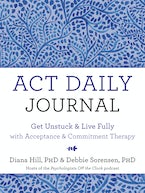By Diana Hill, PhD, coauthor of ACT Daily Journal
When I was little, I wanted to be a snail when I grew up because snails have their homes on their backs wherever they go. Now that I’m an adult, I’ve changed my mind. I want to be a hermit crab.
Hermit crabs get to move shells when they outgrow them. They’re essentially just borrowing the shells they live in, and they courageously take the necessary steps to find a new one when it’s time for change (i.e., growth).
Many of us have felt like hermits this past year, and as the pandemic comes to an end, we may feel exposed and uncertain about leaving our shells. It is how we respond to this uncertainty that will determine how easy or hard this transition will be. If we can remain psychologically flexible, willing, present, and focused on our values, we can better face the vulnerability of opening up our lives and stepping into the next phase.
Research shows that psychological flexibility helps us effectively navigate stressors that are out of our control such as chronic pain, anxious thoughts, and/or loss and grief. More recent studies show that having psychological flexibility at the time of COVID-19 can mitigate feelings of depression, anxiety, and social isolation. It can also help us be better parents and protects our children from the spillover effects of stress. And it can help us with this next phase of reentry in the wake of the pandemic.
The good news is that it is possible to become more psychologically flexible with daily practice. Here are some simple practices I use as a yoga teacher and acceptance and commitment therapy (ACT) practitioner to flex my inner hermit crab.
1. COME BACK HOME — BE PRESENT. When we feel unsteady, it is helpful to land back home in our bodies, in the here and now. In the present moment, you see your thoughts, your behaviors, and the world around you more clearly. You can also make the subtle flexible adjustments needed to respond to life’s inevitable changes and stressors. During yoga, child’s pose serves as a rest between more difficult poses. When life throws you a curveball, take a moment, whenever you need it, to climb back inside your shell and rest in the present moment with your body.
- Hermit Crab (Child’s) Pose. Kneel on the floor with your knees hip-width apart. On an exhale, reach your torso over your knees and rest your arms at your sides. Let your forehead touch the ground. Breathe into your belly, expanding your breath into the front and back of your body. Inhabit your body fully.
2. CONTACT YOUR HEART — CONNECT TO VALUES. Your values are qualities of action you take that demonstrate your caring—like being kind, being curious, or being brave. Living by your values means acting in ways that align with what matters most to you. Values are the guideposts that direct you during times of change. By connecting with your values, you can have more clarity about how you want to act during this or any transition.
- Move your attention to your heart. Try to feel, in your heart, what is most important to you. How do you want to be during this transition? What did the pandemic teach you about what matters most? Notice the feelings, sensations, longings, and images that arise when you ponder your values.
3. YOU ARE NOT YOUR SHELL — TAKE PERSPECTIVE. Transitions are a great time to get perspective on self-stories that are boxing you in. You can spot inflexible self-stories because they often start with “I am,” “I always,” “I never,” or “I can’t.” Self-stories narrow your attention, are self-fulfilling prophecies, and prevent you from seeing other perspectives. Many of the stories you hold about yourself are merely thoughts rather than facts.
- Expand Your View. Imagine you hold in your hands rigid stories about yourself, such as “I can’t handle this change,” or, “I am always socially awkward.” Hold these stories up to your eyes like two cupped shells. Notice how your peripheral vision is narrowed? Now, slowly move your hands away from your face. Take a look at the stories in your hands, and expand your view to the room around you. Open your hands and let them sit at your sides. You are more than the stories your mind creates about you!
4. NOTICE YOUR HEAD — DEFUSE THOUGHTS. Another key process in developing psychological flexibility is being able to notice your mind without being kicked around by it. During times of change our heads have a lot of rules, “shoulds,” and judgments that lead you to be an inflexible mind follower.
- A Play on “Shoulds.” How is your mind nagging you? What are some of the “shoulds” that your head tells you? Examples might be something like: “I should have my life together by now,” or, “I’m not doing enough.” Imagine if you could write one on a blackboard in front of you. Now imagine you could write it again, this time in bubble letters. Now imagine you could write it again, this time in another language! Get playful with your nagging mind and create some space from those “should” thoughts.
5. GET CURIOUS — PRACTICE ACCEPTING. When we feel overwhelmed and stressed, we often act like hermit crabs, climbing back into our shells to hide from pain. But when we run from discomfort, our life narrows and we often experience even more suffering (what we resist persists!). We create new problems by trying to escape the discomfort of the present moment. Taking a stance of curiosity with our mind and body helps us move toward discomfort with more openness. According to neuroscientist Jud Brewer, being curious activates dopamine in our brains, particularly in the hippocampus, which is the area where learning and memory occurs. When we are curious, we are intrinsically motivated to stick with hard things, which facilitates a growth mind-set.
- Be a Curious Crab. When you feel anxiety about change, turn toward these feelings with an inquisitive mind. Where do you notice these feelings in your body? What color are they? Are they moving? Do they have weight? Embody openness and curiosity by unclenching your jaw, letting go of your shoulders, and taking a willing stance. Invite your discomfort, stress, anxiety, and pain in, with kind, open arms. Then say “yes” with your mind.
6. MAKE A MOVE OUTSIDE YOUR SHELL — TAKE COMMITTED ACTION. To be psychologically flexible means you act in ways that align with your deepest values. Committed action involves taking daily steps and actions that create a life of vitality and meaning. On your courageous journey thus far, you’re envisioning your new home, you’ve connected with your heart, taken perspective with your eyes, gotten playful with your thoughts, and opened up with curiosity.
- Now It’s Time to Get Moving with Your Whole Body. Where are your values pointing you? What is a move that would line up with what matters in this moment? Go ahead, move your whole body, and take that step into a new possibility.
Diana Hill, PhD, is a clinical psychologist, and coauthor of ACT Daily Journal. She is also cohost of the popular podcast, Psychologists Off the Clock, and offers regular teachings in compassion and acceptance and commitment therapy (ACT) through InsightLA and Mindful Heart Programs. Through her online teachings, executive coaching, clinical supervision, and private therapy practice, Diana encourages clients to build psychological flexibility so that they can live more meaningful and fulfilling lives.
Diana practices what she preaches in her daily life as a mom of two, homesteader, and yoga teacher. Learn more about her latest offerings here, and follow her on Instagram, Facebook, and Twitter to get tools to build psychological flexibility into your daily life.



 2024 Peace Playbook: 3 Tactics to Avoid Clashes with Your Partner
2024 Peace Playbook: 3 Tactics to Avoid Clashes with Your Partner